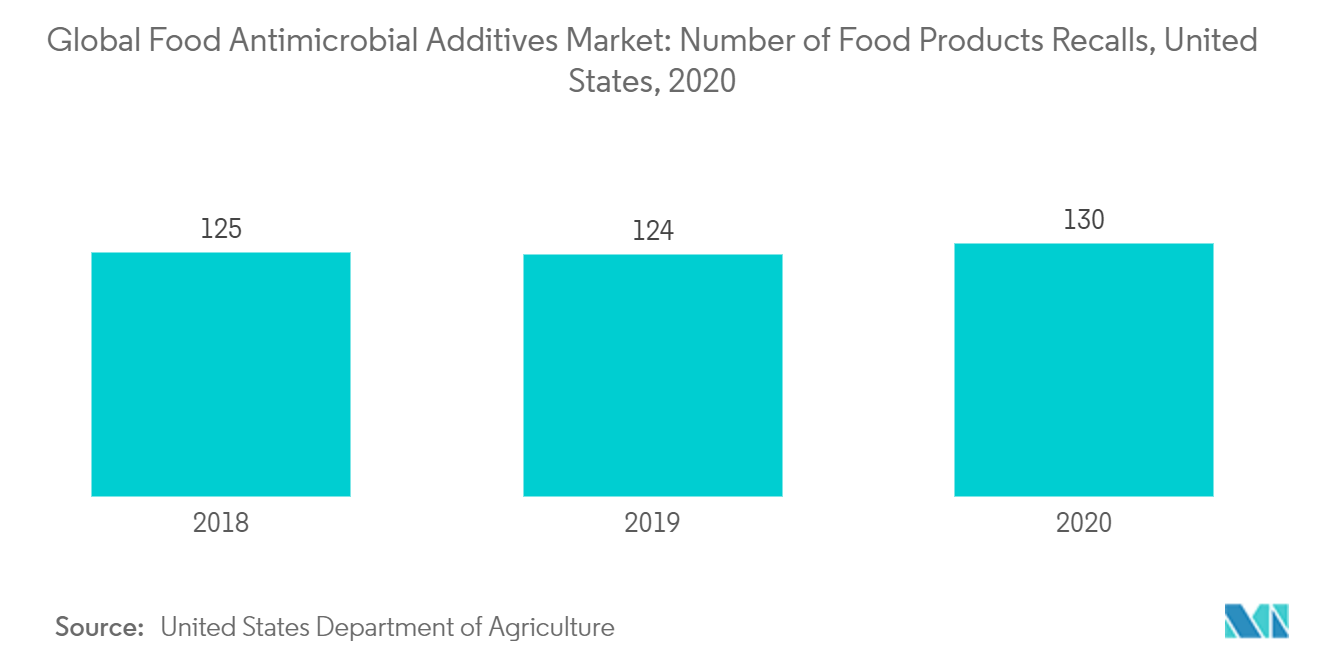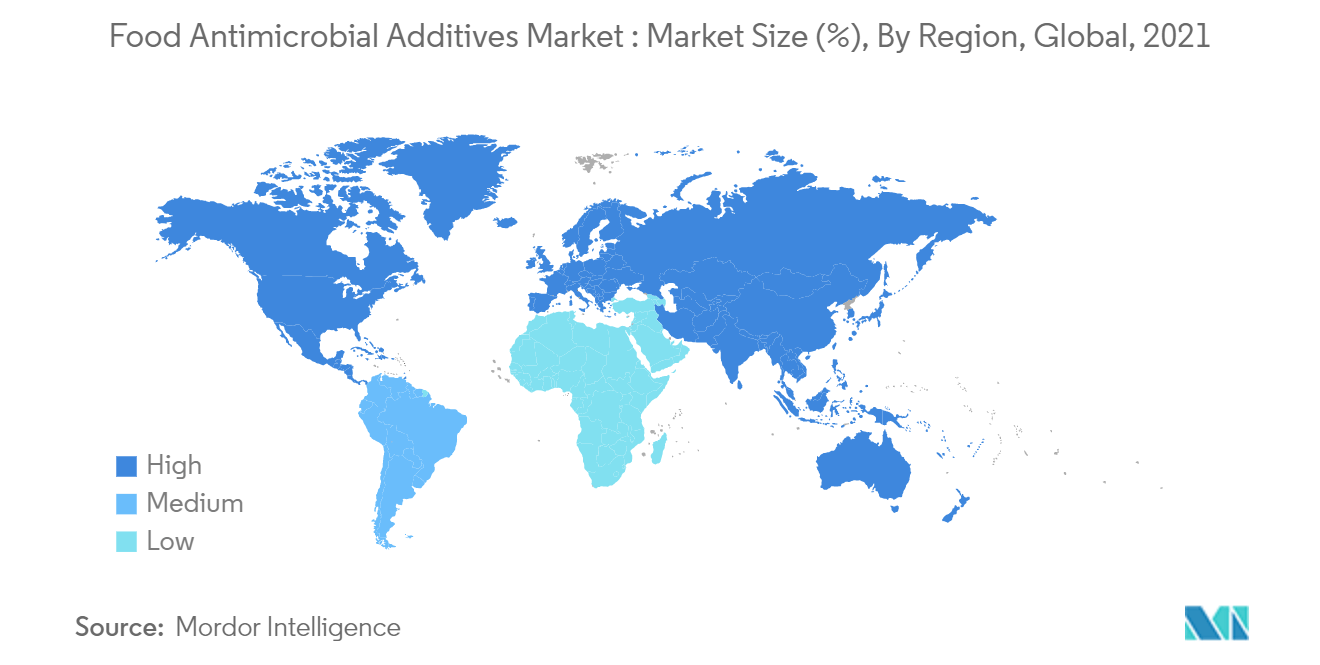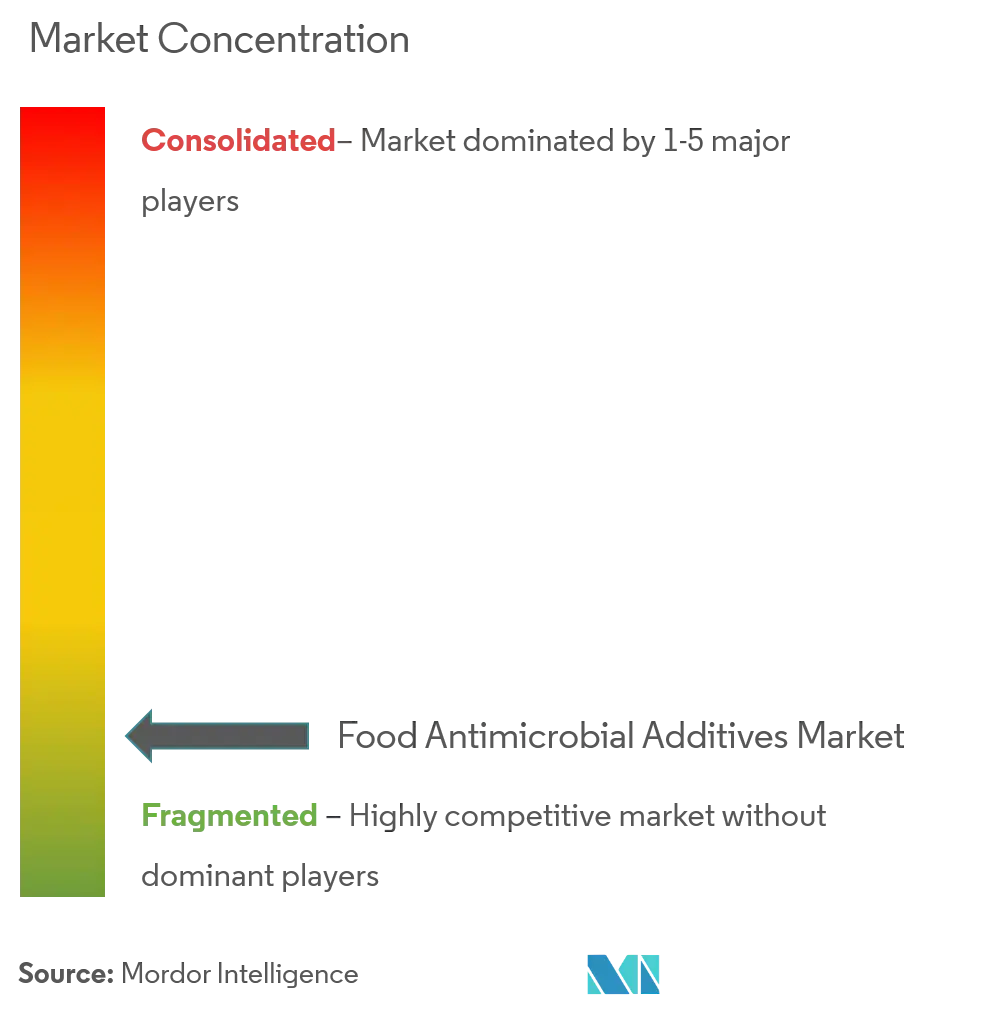Food Antimicrobials Additives Market Size

| Study Period | 2019 - 2029 |
| Base Year For Estimation | 2023 |
| CAGR | 5.16 % |
| Fastest Growing Market | Asia Pacific |
| Largest Market | North America |
| Market Concentration | Low |
Major Players
*Disclaimer: Major Players sorted in no particular order |
Food Antimicrobials Additives Market Analysis
The food antimicrobial additives market is projected to register a CAGR of 5.16% during the forecast period (2022-2027).
The COVID-19 pandemic impacted the producers as there was price fluctuation of raw materials that are utilized to produce antimicrobial additives. Owing to this, there was a hindrance in the cost of the end product. Food and beverage products can be contaminated by a variety of pathogens and spoilage microbiota, the former causing foodborne diseases and the latter causing significant economic losses for the food industry due to undesirable effects on the food properties. Antimicrobial food additives play an important role in the prevention and inhibition of microbial growth in food products.
However, in the meat industry, every giant and small-scale producer is rigorously suspending the utilization of nitrites due to their carcinogenic effect. This enhances the usage of natural antimicrobial additives, like nisin and natamycin, to inhibit mold growth.
Strict regulations such as the Food and Drug Administration (FDA) for antimicrobial additives utilized straightway in processed foods and food-contact items like the packaging of food. This is predicted to hinder the market growth during the forecast period. Adding to this, antimicrobials are one of the top free-from claims consumers nowadays. Thus, pushing the food and beverage product manufacturers to eliminate the use of such antimicrobials is directly hampering the revenue generation in the overall market for food antimicrobial additives.
Food Antimicrobials Additives Market Trends
This section covers the major market trends shaping the Food Antimicrobial Additives Market according to our research experts:
Growing Consumer Interest in Food Safety and Quality
The growth of spoilage microbiota in food products negatively impacts the shelf-life, textural characteristics, and overall quality of the finished products, thus affecting consumer choices and resulting in significant commercial losses. This highlights the urgency and attention with which food spoilage issues should be addressed. Moreover, the rising number of foodborne disease outbreaks, adulteration cases, and toxicity have increasingly manifested the threat to food safety. The Centre for Disease Control and Prevention (CDCP) has reported that one in 10 people fall sick every year due to foodborne illness; most importantly, children under five years of age are at high risk. Also, according to World Health Organization (WHO) estimates, the global burden of foodborne diseases, around 125,000 children die every year because of foodborne illnesses. The growing food safety issues are expected to drive the demand for antimicrobial additives.

North America Dominates the Market
The growing food industry has extensively led to the demand for food antimicrobial additives in the country. The demand for clean-labeled preservatives and antimicrobials, such as vinegar, ascorbic acid, rosemary, and chemicals derived from organic or natural substances, further drives the market studied. North America dominated the food antimicrobial additives market as the demand for clean-labeled antimicrobials and preservatives like ascorbic acid, vinegar, rosemary, and chemicals extracted from natural or organic elements further boosts the market. Thus, manufacturers are investing in R&D activities to introduce clean-label antimicrobials with additional assets to boost sales by satiating the growing demand for clean-label ingredients. The rising demand for beverage and confectionery food products in North America due to the chaotic and working lifestyle, inflated urbanization, and growing hospitality and retail sector is consecutively predicted to drive the market for food antimicrobial additives.

Food Antimicrobials Additives Industry Overview
The food antimicrobial additives market is fragmented and is driven by various active players. The major players are focusing on expanding their market and product range to have a competitive advantage. There are numerous prominent players in the market, such as DuPont de Nemours Inc., Corbion NV, Koninklijke DSM NV, and Galactic. The major players in the market have a broad geographical presence and an extensive product portfolio to cater to numerous consumer demands. This factor assists the company in maintaining a strong foothold in the market. Advanced distribution network and manufacturing expertise give an upper edge to the manufacturers to expand their range of products across the world.
Food Antimicrobials Additives Market Leaders
-
Koninklijke DSM N.V
-
DuPont de Nemours, Inc
-
Corbion N.V
-
Galactic
-
BASF SE
*Disclaimer: Major Players sorted in no particular order

Food Antimicrobials Additives Market News
- In 2021, DuPont announced the completion of the merger of the Nutrition & Bioscience business operation, which is a subsidiary of DuPont, with the subsidiary of International Flavours & Fragrances Inc., at a value of USD 45.4 billion. This merger targets to expand IFF's product portfolio with enzymes, nutrition, soy proteins, cultures, and probiotics categories.
- In 2021, Corbion declared its newly launched clean-label antimicrobial for meat mold inhibition named 'Verdad MP100' on the basis of the ingredients such as ferment blend, vinegar, natural flavor, and citrus flour. Corbion launched this product as consumers demand clean-label ingredients. Hence, this boosts the growth of the food and beverage industry.
- In 2019, Kemin Industries launched 'Fortium® Rvc', which is a clean-label bakery solution in the International Baking Industry Exposition by targeting to capture the speedily growing market of natural food antioxidants.
Food Antimicrobials Additives Market Report - Table of Contents
1. INTRODUCTION
- 1.1 Study Assumptions and Market Definition
- 1.2 Scope of the Study
2. RESEARCH METHODOLOGY
3. EXECUTIVE SUMMARY
4. MARKET DYNAMICS
- 4.1 Market Drivers
- 4.2 Market Restraints
-
4.3 Porter's Five Forces Analysis
- 4.3.1 Threat of New Entrants
- 4.3.2 Bargaining Power of Buyers/Consumers
- 4.3.3 Bargaining Power of Suppliers
- 4.3.4 Threat of Substitute Products
- 4.3.5 Intensity of Competitive Rivalry
5. MARKET SEGMENTATION
-
5.1 By Type
- 5.1.1 Natural
- 5.1.1.1 Nisin
- 5.1.1.2 Natamycin
- 5.1.1.3 Vinegar
- 5.1.1.4 Other Types
- 5.1.2 Synthetic
- 5.1.2.1 Benzoates
- 5.1.2.2 Nitrites
- 5.1.2.3 Sorbates
- 5.1.2.4 Propionates
- 5.1.2.5 Lactates
- 5.1.2.6 Acetates
- 5.1.2.7 Other Types
-
5.2 By Application
- 5.2.1 Bakery and Confectionery
- 5.2.2 Dairy Products
- 5.2.3 Snacks and Savory
- 5.2.4 Beverages
- 5.2.5 Meat and Meat Products
- 5.2.6 Other Applications
-
5.3 Geography
- 5.3.1 North America
- 5.3.1.1 United States
- 5.3.1.2 Canada
- 5.3.1.3 Mexico
- 5.3.1.4 Rest of North America
- 5.3.2 Europe
- 5.3.2.1 Spain
- 5.3.2.2 United Kingdom
- 5.3.2.3 Germany
- 5.3.2.4 France
- 5.3.2.5 Italy
- 5.3.2.6 Russia
- 5.3.2.7 Rest of Europe
- 5.3.3 Asia-Pacific
- 5.3.3.1 China
- 5.3.3.2 Japan
- 5.3.3.3 India
- 5.3.3.4 Australia
- 5.3.3.5 Rest of Asia-Pacific
- 5.3.4 South America
- 5.3.4.1 Brazil
- 5.3.4.2 Argentina
- 5.3.4.3 Rest of South America
- 5.3.5 Middle East & Africa
- 5.3.5.1 Saudi Arabia
- 5.3.5.2 South Africa
- 5.3.5.3 Rest of Middle East & Africa
6. COMPETITIVE LANDSCAPE
- 6.1 Most Active Companies
- 6.2 Most Adopted Strategies
- 6.3 Market Share Analysis
-
6.4 Company Profiles
- 6.4.1 Koninklijke DSM NV
- 6.4.2 The Archer Daniels Midland Company
- 6.4.3 DuPont de Nemours Inc.
- 6.4.4 Corbion NV
- 6.4.5 Galactic
- 6.4.6 BASF SE
- 6.4.7 Jungbunzlauer Suisse AG
- 6.4.8 Cargill Inc.
- 6.4.9 International Flavors & Fragrances Inc.
- 6.4.10 Celanese Corporation
- *List Not Exhaustive
7. MARKET OPPORTUNITIES AND FUTURE TRENDS
8. IMPACT OF COVID-19 ON THE MARKET
** Subject To AvailablityFood Antimicrobials Additives Industry Segmentation
The antimicrobial additive is an operative agent that, when combined in the processing of a component, will obstruct the growth or life of microbes. The global food antimicrobial additives market is segmented by type, including natural and synthetic. Natural additives include nisin, natamycin, vinegar, and other types. The synthetic section is further divided into benzoates, nitrites, sorbates, propionates, lactates, acetates, and other types. Based on application, the market is segmented into bakery and confectionery, dairy products, snacks and savory, beverages, meat and meat products, and other applications. Also, the study provides an analysis of the food antimicrobial additives market in the emerging and established markets across the world, including North America, Europe, Asia-Pacific, South America, and Middle East & Africa. The report offers the market size and forecasts in terms of value (in USD million) for all the above segments.
| By Type | Natural | Nisin |
| Natamycin | ||
| Vinegar | ||
| Other Types | ||
| By Type | Synthetic | Benzoates |
| Nitrites | ||
| Sorbates | ||
| Propionates | ||
| Lactates | ||
| Acetates | ||
| Other Types | ||
| By Application | Bakery and Confectionery | |
| Dairy Products | ||
| Snacks and Savory | ||
| Beverages | ||
| Meat and Meat Products | ||
| Other Applications | ||
| Geography | North America | United States |
| Canada | ||
| Mexico | ||
| Rest of North America | ||
| Geography | Europe | Spain |
| United Kingdom | ||
| Germany | ||
| France | ||
| Italy | ||
| Russia | ||
| Rest of Europe | ||
| Geography | Asia-Pacific | China |
| Japan | ||
| India | ||
| Australia | ||
| Rest of Asia-Pacific | ||
| Geography | South America | Brazil |
| Argentina | ||
| Rest of South America | ||
| Geography | Middle East & Africa | Saudi Arabia |
| South Africa | ||
| Rest of Middle East & Africa |
Food Antimicrobials Additives Market Research FAQs
What is the current Food Antimicrobial Additives Market size?
The Food Antimicrobial Additives Market is projected to register a CAGR of 5.16% during the forecast period (2024-2029)
Who are the key players in Food Antimicrobial Additives Market?
Koninklijke DSM N.V, DuPont de Nemours, Inc, Corbion N.V, Galactic and BASF SE are the major companies operating in the Food Antimicrobial Additives Market.
Which is the fastest growing region in Food Antimicrobial Additives Market?
Asia Pacific is estimated to grow at the highest CAGR over the forecast period (2024-2029).
Which region has the biggest share in Food Antimicrobial Additives Market?
In 2024, the North America accounts for the largest market share in Food Antimicrobial Additives Market.
What years does this Food Antimicrobial Additives Market cover?
The report covers the Food Antimicrobial Additives Market historical market size for years: 2019, 2020, 2021, 2022 and 2023. The report also forecasts the Food Antimicrobial Additives Market size for years: 2024, 2025, 2026, 2027, 2028 and 2029.
Food Antimicrobials Additives Industry Report
Statistics for the 2024 Food Antimicrobials Additives market share, size and revenue growth rate, created by Mordor Intelligence™ Industry Reports. Food Antimicrobials Additives analysis includes a market forecast outlook 2029 and historical overview. Get a sample of this industry analysis as a free report PDF download.



